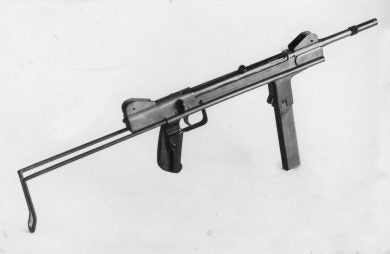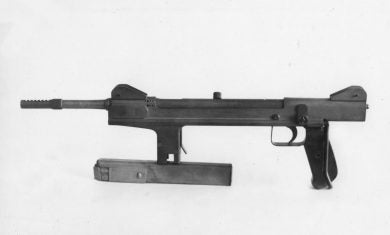It has often been said, written, and posted that for each firearm that reaches full production, fielding, and general fame, countless models just happen not to go past the prototype/experimental stage, and maybe an even larger number never even left the drawing board. This, of course, is a worldwide phenomenon, but seems even more interesting to look at when industrially less important nations are examined, as in the case of Brazil. Latin America’s largest nation has also had its share of little known gun designers, and one them has been brought to TFB readers’ attention in this recent series of posts. The last one comes now, and will tell you how it all started.
Nelmo Suzano was born in Vitória, Espírito Santo State, in 1928, moving to Rio de Janeiro, then capital of Brazil, at an early age. That schoolboy’s copybooks soon began to be filled with drawings of guns and firing mechanisms of all types, both copied from the scarce technical publications he was able to get and from his own mind. Having joined the Brazilian Army at the age of 18 in the mid-1940s, he was promptly accepted as a member of the shooting team of the 8 Grupo de Artilharia de Costa Motorizado (8th Coastal Artillery Motorized Group), in Rio, also quickly becoming a medal-winning shooter. In the 1950s, having already accumulated a lot of hands-on experience with different types of firearms and their inner guts, he was invited to work, as a civilian technician, in the weapons maintenance department Brazilian Air Force’s Santa Cruz Air Base, in a suburb of the same city. The wide experience thus gained with taking apart, repairing and modifying military-issue weapons, from pistols through rifles to machine guns, was the basis for a valuable, self-taught educational process in the firearms field.
Later on, still in the Fifties, Nelmo established a partnership with his friend Olympio Vieira de Mello Filho to open a small firm in Rio de Janeiro, O.N. Gunmakers (an English-language name was expected to give it more credibility…), with the main purpose of making/adapting/transforming high-quality hunting guns. They did, in fact, progress pretty well and came out with several top-notch rifles that found a selected clientele at that time, with many orders coming from foreign countries. Guns were in calibers ranging for the then-usual 7x57mm Mauser to such African heavyweights as the .458 Winchester Magnum, .460 Weatherby Magnum, and the .500 Nitro Express. “O.N.” marked rifles are still reportedly present in some international collections, some of them having never fired a single bullet!
But it was automatic weapons that would attract Nelmo’s attention most in the years to come. In the 1960s, his first private venture project took the shape of a submachine gun that never received any designation or name, proper, which he many years later referred to in talks with the author as the “Sem Nome” (the “Nameless”). Regrettably , he had kept no written records of its dimensional and weight characteristics, and what follows came from informal talks with the designer.

The dual-caliber “Sem nome” was Nelmo Suzano’s first venture into SMG design and construction. The weapon is seen here with the wooden detachable shoulder stock in place.
The weapon had a delayed blowback action, although the actual way of achieving the retarding of the bolt rearwards travel has remained unclear. By changing barrels, magazines, and adding an adapter to the bolt face, either 9x19mm or .45ACP ammunition could be used. The body had a rectangular shape and was made of 2mm thick steel plate, where the cylindrical receiver fit. The barrel was adapted from one that came from an old .458 Winchester Magnum rifle, featuring a seven-slot compensator at the muzzle. The cylinder-shaped cocking piece was fixed to the bolt and set about 45 degrees to the right, the fire selector (safe/auto) being located on the left side of the body, above the trigger. Massive steel ears protected both the rear (flip apertures for 100 and 200 meters)) and front (blade) sights.

The weapon with the permanently-fitted telescopic wire stock in the extended position.
An unusual double-stock system was used in which the shoulder buttplate of the wire stock, when retracted, fit flush with the sides of the pistol grip and allowed a wooden stock to be attached to the weapon. The magazine housing was well forward, being large enough to be used as a support grip. The release lever was a blade at the rear of the mag well, being pulled rearwards (a somewhat awkward job) to allow removal of the empty unit. As shown in the rare photos posted here, the “Nameless” was a pretty long SMG with an overall length in the region of 600mm, and weight was on the heavier side, slightly over 4kg.

A very clear side photo of Nelmo’s first buzzgun. Massive fire selector above the trigger area is evident, as well as the multi-slot compensator at the muzzle.
Being only a prototype for studies and never officially tested by the Brazilian Army, it appears to have worked satisfactorily and, when demonstrated to Força Pública de São Paulo (São Paulo Public Force), the forerunner of the present Polícia Militar (Military Police), it was considered for possible adoption by that LE agency. Initial plans for further development and the establishment of a production facility in São Paulo City were made, but, never materialized.

As already mentioned in this series, Nelmo Suzano died in Rio de Janeiro in 2013. R.I.P. my friend!
 Your Privacy Choices
Your Privacy Choices
